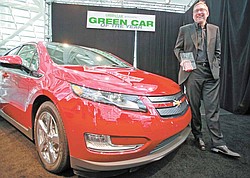Electric cars thrill, worry utilities
ASSOCIATED PRESS
Joel Ewanick, General Motors Co. vice president for U.S. Marketing, holds the award won by the Chevy Volt as 2011 Green Car of the Year, presented by Green Car Journal, at the L.A. Auto Show Thursday, Nov. 18, 2010.
Associated Press
NEW YORK
The first mass-market electric cars go on sale next month, and the nation’s electric utilities couldn’t be more thrilled — or worried.
Plugged into a socket, an electric car can draw as much power as a small house. The surge in demand could knock out power to a home, or even a neighborhood. That has utilities in parts of California, Texas and North Carolina scrambling to upgrade transformers and other equipment in neighborhoods where the Nissan Leaf and Chevrolet Volt are expected to be in high demand.
Not since air conditioning spread across the country in the 1950s and 1960s has the power industry faced such a growth opportunity. Last year, Americans spent $325 billion on gasoline, and utilities would love even a small piece of that market.
The main obstacles to wide-scale use of electric cars are high cost and limited range, at least until a network of charging stations is built. But utility executives fret that difficulties keeping the lights on for the first crop of buyers—and their neighbors—could slow the growth of this new niche.
Auto executives say it’s inevitable that utilities will experience some difficulties early on. “We are all going to be a lot smarter two years from now,” says Mark Perry, director of product planning for Nissan North America.
Electric cars run on big batteries that are charged by plugging into a standard wall socket or a more-powerful charging station. A combined 30,000 Nissan Leafs and Chevrolet Volts are expected to be sold over the next year. Over the next two years, Ford, Toyota and every other major automaker also plan to offer electric cars.
Governments are promoting the expensive technology as a way to reduce dependence on foreign oil, cut greenhouse-gas emissions and improve air quality. Congress is offering electric-car buyers a $7,500 tax credit, and some states and cities provide additional subsidies that can total $8,000. The Leaf sells for $33,000, and the Volt sells for $41,000.
Electric cars produce no emissions, but the electricity they are charged with is made mostly from fossil fuels such as coal and natural gas that do. Still, electric cars produce two-thirds fewer greenhouse-gas emissions, on average, than a similarly sized car that runs on gasoline, according to the Natural Resources Defense Council.
Driving 10,000 miles on electricity will use about 2,500 kilowatt-hours, or 20 percent more than the average annual consumption of U.S. homes. At an average utility rate of 11 cents per kilowatt-hour, that’s $275 for a year of fuel, equivalent to about 70 cents per gallon of gasoline.
Nationwide, utilities have enough power plants and equipment to power hundreds of thousands of electric cars. Problems could crop up long before that many are sold, though, because of a phenomenon carmakers and utilities call “clustering.”
Electric vehicle clusters are expected in neighborhoods where:
Generous subsidies are offered by states and localities
Weather is mild, because batteries tend to perform better in warmer climates
High-income and environmentally conscious commuters live.
 43
43

